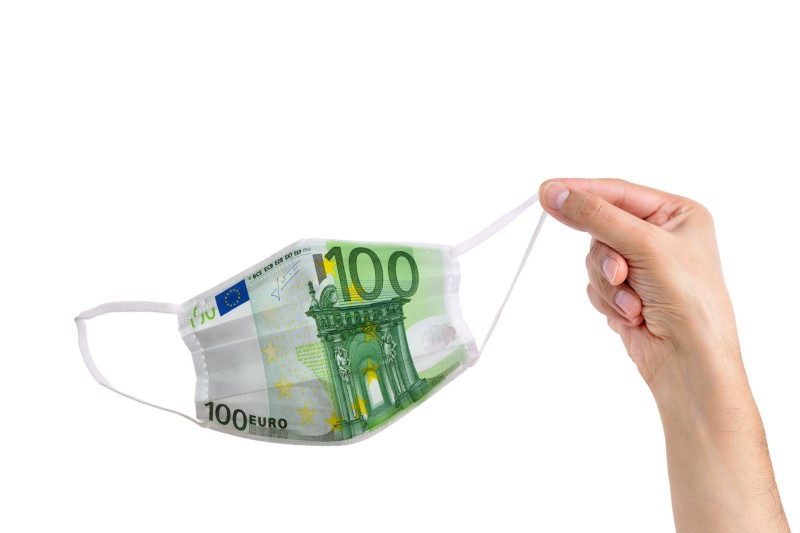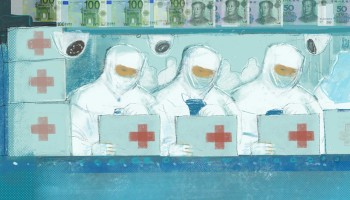As countries across Europe went into lockdown earlier this year to fight the COVID-19 pandemic, there was one early and obvious casualty: transparency. In the rush to obtain critical supplies, many countries suspended their usual public procurement rules, resulting in billions of euros of spending that remains largely hidden from the public.
So we at the Organized Crime and Corruption Reporting Project (OCCRP) decided to find out what happened to that money.
Along with media partners in 37 countries, we collected information from over 37,800 COVID-19 related tenders and contracts worth over 21 billion euros (U.S $24.9 billion), running from February to October this year. They cover key goods such as personal protective equipment (PPE), ventilators, tests, and medications.
What we found was often fascinating. Governments bought respirator masks at prices that varied wildly, from just 20 cents per unit to 37 euros each. The pandemic also prompted a boom for hydroxychloroquine and chloroquine, controversial drugs promoted by many as a miracle treatment for COVID-19, despite limited evidence. Data obtained by reporters showed the number of large contracts for these drugs increased 15-fold so far this year. Dexamethasone, a steroid that has met with more clinical success, saw a 36-fold increase.
You can browse the data yourself at our interactive here.
The data is far from complete, but it gives an unprecedented view of just what Europe’s governments have been spending their billions on — and where things may have gone astray.
Bargains and Black Holes
The data we obtained gives just a snapshot of Europe’s COVID-19 spending. We pulled data from the European Union’s procurement portal, Tenders Electronic Daily, and national and regional governments.
The number of contracts we obtained from each country reflected its level of transparency, not necessarily how much it spent.
We obtained the most contracts, roughly 15,000, from Portugal. Despite its relatively small size, it was one of the few European countries to publish all its contracts online, along with an overview of its COVID-19 related purchases.The runner-up, with 12,000 contracts, was Russia.
Other countries have been virtual black holes of information. Belgium, the Netherlands, and Denmark rejected reporters’ data requests outright, typically arguing that it was necessary to preserve secrecy so as to not undermine negotiations for the purchase of goods. In response to a freedom-of-information request, Norway provided some details on contracts, such as company names, but would not give price information.
Keep scrolling down to see more.
Big Contracts, Little Competition
The 20.8 billion euros’ worth of contracts that we collected included some very big deals.
Nearly half the total (10 billion euros) are contracts from the U.K., including a series of PPE purchases by the Department of Health and Social Care for 4.9 billion euros.
The largest single national contract was in Spain, where the government bought 181 million euros’ worth of PPE in a no-bid deal.
We obtained 3.4 billion euros’ worth of tenders from the European Commission on joint procurement and two billion euros of tenders from Germany.
The majority of tenders and contracts that we obtained — 12.6 billion euros’ worth — were awarded to buy PPE, such as respirator masks, gloves and protective suits. 3.1 billion was spent on COVID-19 tests and 2.5 billion was spent on ventilators.
We first focused on the most valuable one percent of tenders and contracts. These ranged in value from 1 million to 1.5 billion euros.
The majority of these most valuable deals were for personal protective equipment (PPE) and ventilators. Also significant were COVID-19 tests and construction of temporary hospitals.
The data is divided between tenders (on the left) and individual contracts (on the right). Tenders were often larger, and covered deals for multiple goods. Contracts tended to be smaller and centered around a one-time purchase.
The data shows that the vast majority of the biggest deals were given as direct awards, with no open bidding process.
The data we gathered often contained little information, such as VAT numbers, that could be used to identify the companies that won the contracts. Often what we did find was odd, such as widely varying mask prices.
Breathtaking Deals on Masks
Of the medical equipment and PPE deals that we collected, we were able to determine the prices paid per unit for about three billion euros’ worth of deals.
Some of the most interesting information was on PPE respirators (the kind of masks that are able to filter out most viral particles), which have been in high demand for healthcare and essential workers. We found 1.8 billion euros’ worth of deals for Europe’s gold standard for respirators, FFP2, and other equivalent models (known as N95 in the United States and KN95 in China).
The prices paid for FFP2 and equivalent masks varied widely. Half of those purchased cost less than 3.27 euros each, and 75 percent cost less than 4.9 euros each. The cheapest 25% of masks cost under 2.2 euros.
But then there were the outliers such as Ukraine and Czechia, where we found cases in which as much as 37 euros was paid per mask.
The chart below shows how the three billion euros spent on PPE and medical equipment breaks down. FFP2 respirator masks are by far the biggest item, followed by other types of masks. Ventilators, protective suits, and COVID-19 tests trail behind.
In total, we got data for the purchase of 640 million FFP2 and equivalent respirators. Here are the prices paid by each country. The size of each bubble indicates how many masks were bought at each price point.
Ukraine and Czechia had the wildest variance in prices paid for FFP2 masks, ranging from just over 20 cents per unit to as much as 37 euros. (In the Czech case, the cheap masks turned out to be the wrong kind, and failed to meet filtration standards to protect essential workers.)
If we switch to a logarithmic scale, we can see even more clearly which countries had the biggest variance in prices paid for FFP2 masks.
Some countries got better deals than others.
In Slovakia, nearly all the masks purchased were more expensive than the Europe-wide median of 3.27 euros.
On the other end of the scale, Italy managed to secure most of its masks at below-average prices.
A Boom in Medication
The pandemic caused the EU-27 countries to import nearly 5.2 percent more medicine between February to July compared to the same period the year before — a roughly one billion euro increase.
The biggest winners were brand-name drug manufacturers, with almost half of the biggest contracts going to the Swiss pharmaceutical giant Roche. Three-quarters of all contracts went to four Big Pharma companies: Roche, Sanofi, Novartis, and Allergan.
Much of this increase was for medicines that have been repurposed, sometimes controversially, as COVID-19 treatments. Take, for example, hydroxychloroquine and chloroquine, anti-malaria drugs that were touted as a potential COVID treatment but have met with limited success in practice. From February to October this year, 31 large contracts were completed for both medicines, compared to just two in all of 2019.
Dexamethasone, a corticosteroid usually used for a range of ailments, from allergies to arthritis, also exploded in popularity. The data we obtained showed the number of large tenders for the drug grew from just six in the whole 2019 to 215 for so far this year.
Re-use of data
The data can be freely copied, redistributed, transformed, and built upon.
Data was gathered between April and October 2020. The collection was done by multiple parties from many sources. We have tried to ensure high quality, but there may be problems such as duplicate entries or missing information. OCCRP provides no guarantees as to the correctness and completeness of the data; however, we are open to helping interested journalists and researchers obtain original source documents.
Journalists from HETQ (Armenia), profil (Austria), Ostro (Slovenia), Investigace (Czechia), De Tijd (Belgium), Bivol (Bulgaria), DR (Denmark), YLE (Finland), NRK (Norway), Fundacija Reporterow (Poland), BR Data (Germany), Atlatszo (Hungary), IRPI (Italy), Re: Baltica (Latvia), Eesti Päevaleht (Estonia), Atlatszo (Hungary), Reporter.lu (Luxemburg), Follow the Money (Netherlands), NRK (Norway), Fundacija Reporterow (Poland), Publico (Portugal), Times of Malta, KRIK (Serbia), RISE Romania, Finance Uncovered (UK), The Times (UK), The Irish Times (Ireland), IRL Macedonia as well as Sylke Gruhnwald (freelance, Switzerland), Ola Westerberg (freelance, Sweden), Michele Catanzaro (freelance, Spain) and Staffan Dahllöf (freelance, Denmark) contributed reporting.
Special thanks to Transparency International and its local chapters across Europe as well as OpenOpps.
Clarification: This story was updated on October 26 with additional tender data that was erroneously left out of the original version.







